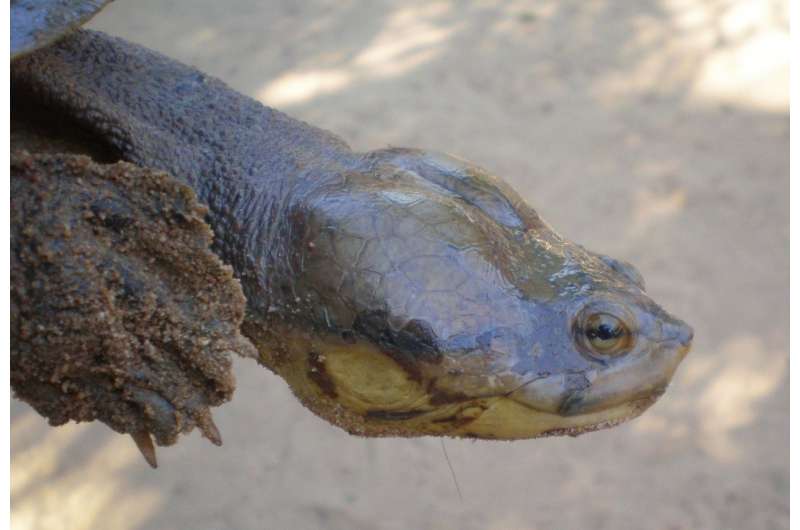Dahl's toad-headed turtle threatened by fragmented habitat, shrinking populations

A recent study published in Conservation Genetics by researchers from the Universidad de los Andes, Universidad Nacional de Colombia, WCS (Wildlife Conservation Society), and the Turtle Survival Alliance (TSA) shows that the Dahl's Toad-headed Turtle (Mesoclemmys dahli), a rare reptile found only in Colombia, is threatened with extinction due to alarmingly small and fragmented populations and high levels of inbreeding.
The authors of the study will pursue both a genetic rescue strategy for the species to reduce inbreeding and an initiative to identify and protect the most important areas for the Dahl's Toad-Headed Turtle.
The Dahl's Toad-headed Turtle's only habitat - dry tropical forests along the Caribbean coast of Colombia - is also one of the most heavily impacted and degraded ecosystems in the country. Current estimates show that it has declined to less than 10 percent of its original range, and mostly consists of isolated and relatively small patches of land.
This habitat conversion and fragmentation can have serious negative consequences for the ecosystem's wild species. In the case of the Dahl's Toad-headed Turtle, locally known as "carranchina" or "montañera," these consequences include a reduction in the overall population size, and loss of genetic exchange and increase in inbreeding.
Authors of the study titled "Genetic evidence of fragmented populations and inbreeding in the Colombian endemic Dahl's toad-headed turtle" are: Natalia Gallego-García and Susana Caballero of the Universidad de los Andes; Mario Vargas-Ramírez of the Universidad Nacional de Colombia; and Germán Forero-Medina of WCS and TSA.
"This is an important study as it clearly demonstrates the negative effects of inbreeding as a result of habitat fragmentation and isolation of small populations," said TSA President Rick Hudson. "Moreover, it points to the need for genetic rescue and protection of important source populations that are still genetically viable. Land purchase and habitat restoration will be critical if this species is to survive."
"Small population sizes and habitat fragmentation are well known threats to animals with limited mobility, but the impacts of these factors are hard to observe in wild populations," said Forero-Medina, Species and Science Director for WCS's Colombia Program and a study co-author. "Genetic research can alert us to the occurrence of inbreeding and its potential negative effects on turtle populations, and inform conservation strategies to save this species."
The Dahl's Toad-headed Turtle lives in small bodies of water, streams, and small aquifers. The species' area of distribution is very restricted, and has decreased even further due to the degradation of its habitat as a result of various agricultural activities, like farming and cattle.
In an effort to learn more about the ecological needs of the Dahl's Toad-headed Turtle, the researchers surveyed Colombia's remaining tropical dry forests for a year and a half looking for the turtles. Blood samples were collected from 127 individual turtles across their entire range and later analyzed in the genetics laboratory of the Universidad de los Andes.
The results from the study show important and alarming findings: the species is fragmented into at least four subpopulations, and although it still has high levels of genetic diversity, groups of individuals are small, isolated, and rarely in contact with other groups. Because of this isolation, all four subpopulations show potentially harmful levels of inbreeding, which increases the likelihood of dangerous mutations appearing in individuals and possibly an inability to reproduce.
To counteract this trend, researchers urgently recommend implementing a genetic rescue strategy, which would involve: moving turtles between subpopulations to reduce inbreeding; establishing a protected area for the species; and implementing an ambitious plan to restore the tropical dry forest. In addition to leading the genetic rescue strategy, WCS Colombia will work with the Rainforest Trust to identify and evaluate sites for a potential protected area for the species.
The strategy, the authors say, will benefit the survival conditions of the turtle and other flora and fauna endemic to the ecosystem. The Dahl's Toad-headed Turtle is currently listed as "Critically Endangered" on the IUCN's Red List of Threatened Species.
More information: Natalia Gallego-García et al, Genetic evidence of fragmented populations and inbreeding in the Colombian endemic Dahl's toad-headed turtle (Mesoclemmys dahli), Conservation Genetics (2017). DOI: 10.1007/s10592-017-1021-z
Journal information: Conservation Genetics
Provided by Wildlife Conservation Society



















